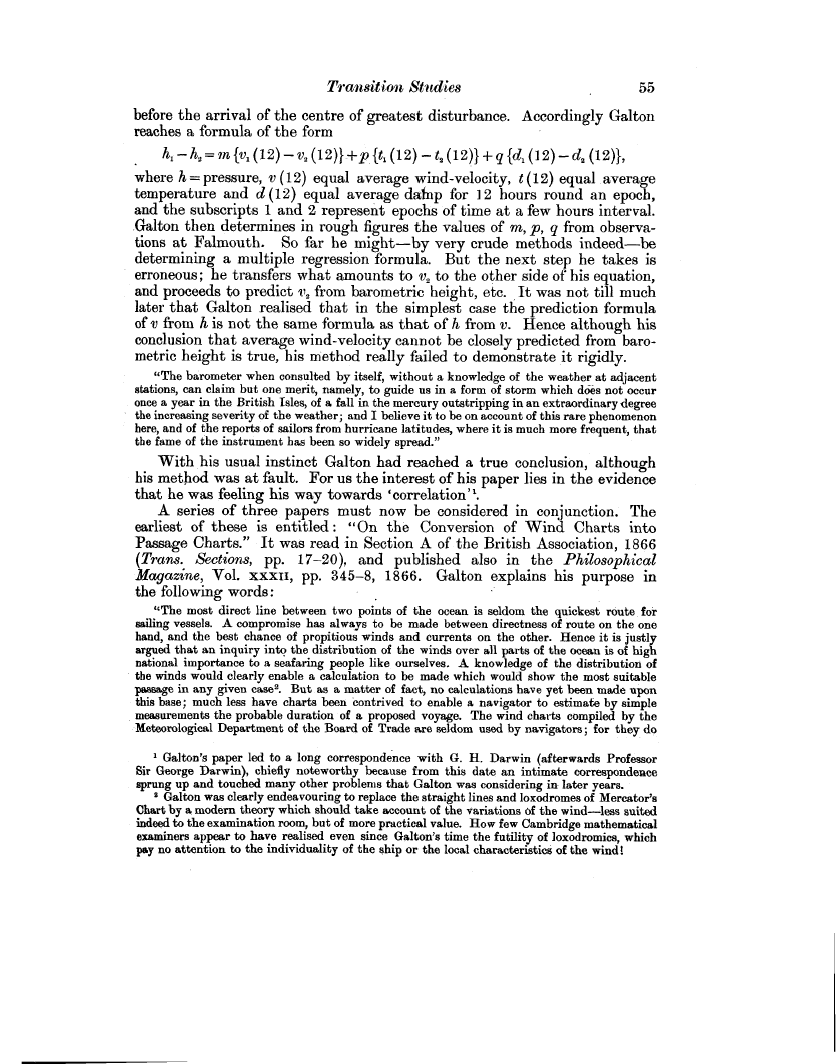Transition Studies 55
before the arrival of the centre of greatest disturbance. Accordingly Galton reaches a formula of the form
h1-h2=in{v,(12)-v2(12)}+p{t,(12)- t2(12)}+q{d1(12)-d2 (12)},
where h = pressure, v (12) equal average wind-velocity, t (12) equal average temperature and d (12) equal average damp for 12 hours round an epoch, and the subscripts 1 and 2 represent epochs of time at a few hours interval. .Galton then determines in rough figures the values of m, p, q from observations at Falmouth. So far he might-by very crude methods indeed-be determining a multiple regression formula. But the next step he takes is erroneous; he transfers what amounts to v2 to the other side of his equation, and proceeds to predict v2 from barometric height, etc. It was not till much later that Galton realised that in the simplest case the prediction formula of v from h is not the same formula as that of h from v. Hence although his conclusion that average wind-velocity cannot be closely predicted from barometric height is true, his method really failed to demonstrate it rigidly.
"The barometer when consulted by itself, without a knowledge of the weather at adjacent stations, can claim but one merit, namely, to guide us in a form of storm which does not occur once a year in the British Isles, of a fall in the mercury outstripping in an extraordinary degree the increasing severity of the weather; and I believe it to be on account of this rare phenomenon here, and of the reports of sailors from hurricane latitudes, where it is much more frequent, that the fame of the instrument has been so widely spread."
With his usual instinct Galton had reached a true conclusion, although his method was at fault. For us the interest of his paper lies in the evidence that he was feeling his way towards `correlation' 1.
A series of three papers must now be considered in conjunction. The earliest of these is entitled : "On the Conversion of Wind Charts into Passage Charts." It was read in Section A of the British Association, 1866 (Trans. Sections, pp. 17-20), and published also in the Philosophical Magazine, Vol. xxxii, pp. 345-8, 1866. Galton explains his purpose in the following words:
"The most direct line between two points of the ocean is seldom the quickest route for sailing vessels. A compromise has always to be made between directness of route on the one hand, and the best chance of propitious winds and currents on the other. Hence it is justly argued that an inquiry into the distribution of the winds over all parts of the ocean is of high national importance to a seafaring people like ourselves. A knowledge of the distribution of the winds would clearly enable a calculation to be made which would show the most suitable passage in any given case2. But as a matter of fact, no calculations have yet been made upon this base; much less have charts been contrived to enable a navigator to estimate by simple measurements the probable duration of a proposed voyage. The wind charts compiled by the Meteorological Department of the Board of Trade are seldom used by navigators; for they do
1 Galton's paper led to a long correspondence with G. H. Darwin (afterwards Professor Sir George Darwin), chiefly noteworthy because from this date an intimate correspondence sprung up and touched many other problems that Galton was considering in later years.
2 Galton was clearly endeavouring to replace the straight lines and loxodromes of Mercator's Chart by a modern theory which should take account of the variations of the wind-less suited indeed to the examination room, but of more practical value. How few Cambridge mathematical examiners appear to have realised even since Galton's time the futility of loxodromics, which pay no attention to the individuality of the ship or the local characteristics of the wind!

